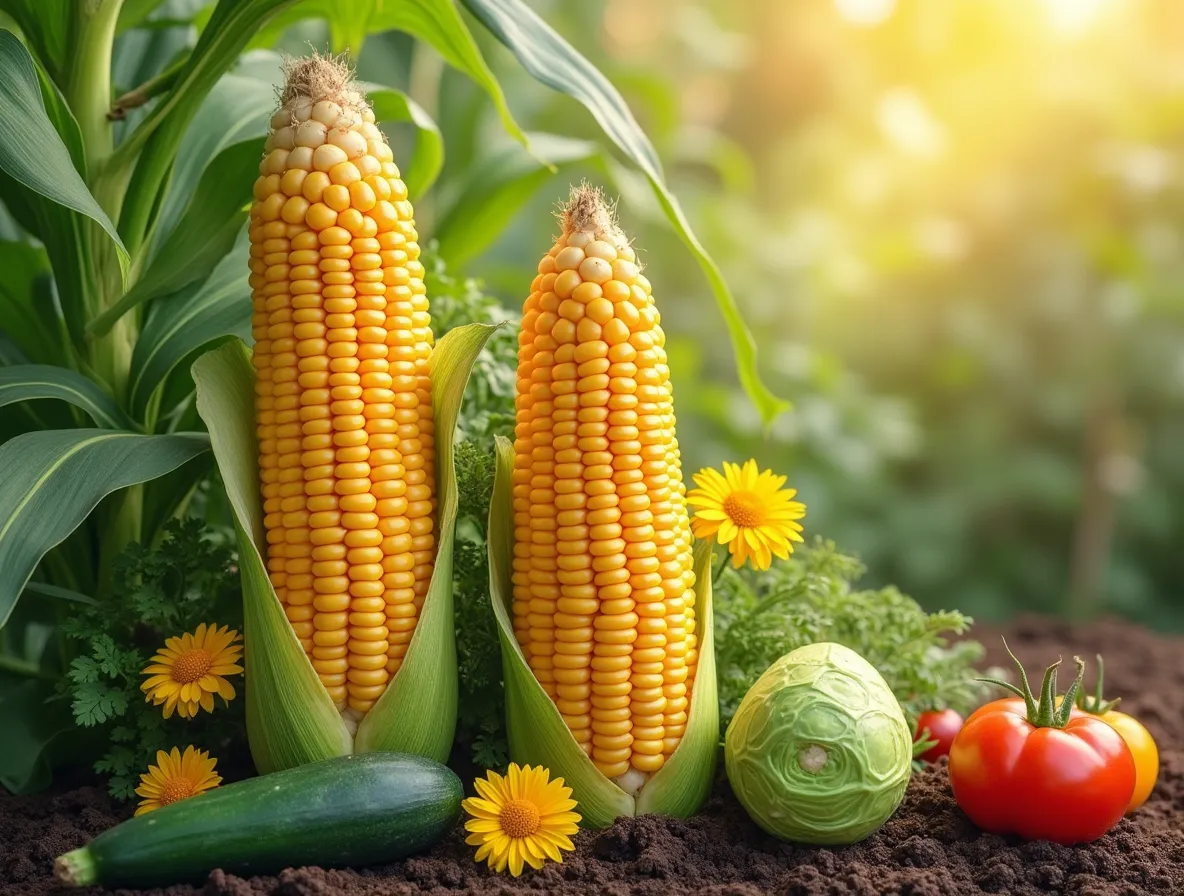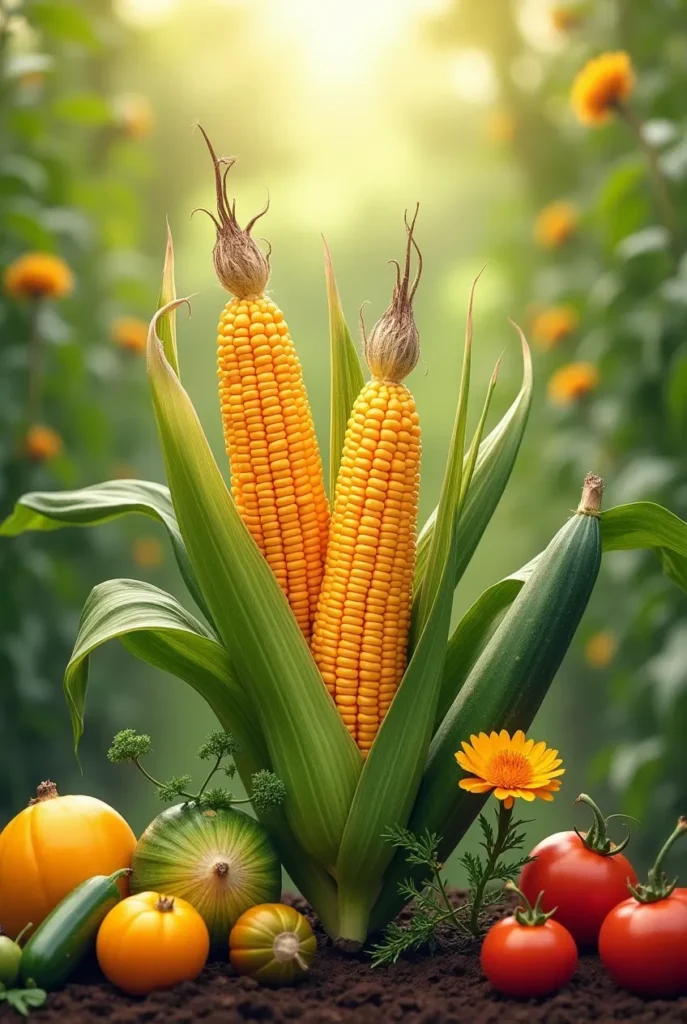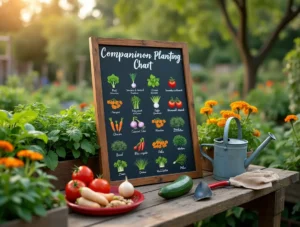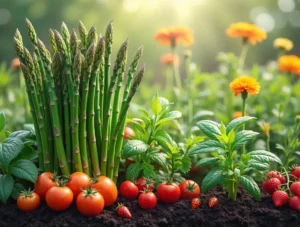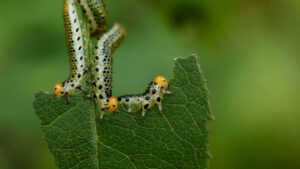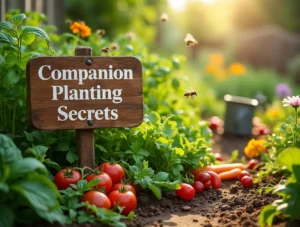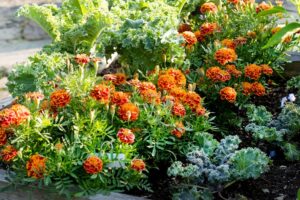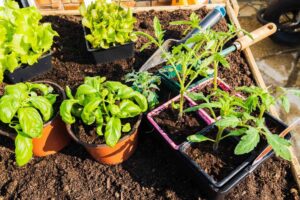Corn companion plants are the secret to plump, golden cobs bursting with sweetness. For over 3,000 years, Native Americans paired corn with beans and squash—a method modern science now proves boosts yields by 30%. In this guide, you’ll discover 25+ science-backed corn companion plants to grow (and 5 to avoid) for your juiciest harvest yet..
In this guide, you’ll discover 25+ science-backed companion plants to transform your corn patch. From pest-fighting herbs like basil and dill to nitrogen-rich beans and weed-blocking squash, these pairings slash the need for chemicals while supercharging your harvest. Plus, learn which plants to avoid (spoiler: tomatoes and cabbage are troublemakers
On This Page
Why Companion Planting Works for Corn
Companion planting isn’t just folklore—it’s a smart, natural way to supercharge your corn’s growth. Here’s why it works:
Pest Control Without Chemicals
Corn earworms, aphids, and raccoons can wreck your crop. But plants like marigolds, basil, and nasturtiums act as bodyguards:
- Marigolds repel nematodes and aphids with their pungent scent.
- Dill attracts parasitic wasps that devour hornworms.
- Squash vines have prickly leaves that deter raccoons.
Science backs this: Studies show intercropping corn with pest-repellent plants reduces infestations by up to 60%!
Free Fertilizer (Thanks to Nitrogen!)
Corn is a heavy feeder, but beans and peas are natural nitrogen factories. Their roots host bacteria that convert air nitrogen into plant-friendly fuel. This cuts your need for synthetic fertilizers and boosts corn’s growth by 20-30% in trials.
Weed Suppression & Moisture Retention
Sprawling plants like squash, cucumbers, and melons act as living mulch:
- Their dense foliage blocks weeds.
- Shades soil to lock in moisture (key during droughts!).
In China, farmers pair corn with zucchini to save water and double yields
Space-Saving Synergy
Tall corn stalks support climbing beans, while low-growing lettuce or spinach thrives in their shade. This “stacked” system lets you grow 3x more food in the same space!
Science Meets Tradition
The Three Sisters method (corn, beans, squash) has thrived for millennia—and modern research proves why:
- Corn provides structure for beans.
- Beans fertilize the soil.
- Squash suppresses weeds.
New twists, like swapping squash for melons or adding garlic (proven to deter earworms), keep this ancient hack fresh.
The Top 25+ Corn Companion Plants (Backed by Science!)
Transform your corn patch into a thriving ecosystem with these powerhouse plants. Bonus: Many double as pest fighters, soil boosters, or space-saving partners!
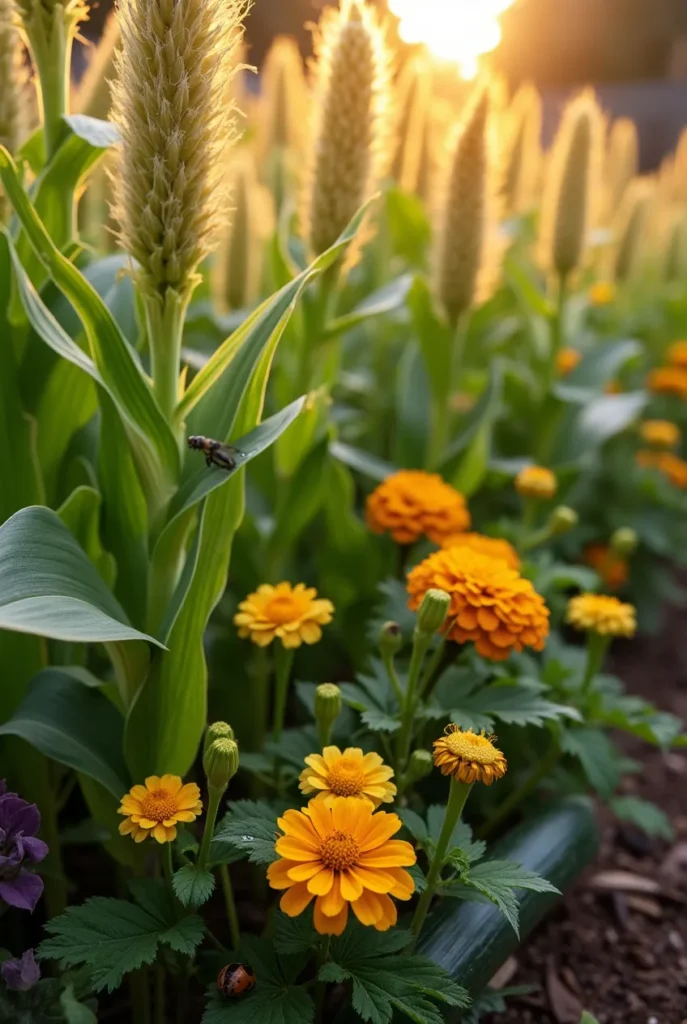
Vegetables & Legumes
- Beans & Peas
- Why: Fix nitrogen in soil (free fertilizer!). Pole beans climb corn stalks.
- Science Tip: Trials show corn yields jump 20-30% when paired with beans.
- Squash (Summer & Winter)
- Why: Sprawling leaves block weeds, retain moisture. Prickly vines deter raccoons.
- Cucumbers
- Why: Use corn stalks as trellises. Keeps fruit off damp ground (less rot!).
- Pro Tip: Space 12 inches apart to avoid root competition.
- Melons & Watermelons
- Why: Living mulch conserves water. Chinese farms use this to double yields!
- Potatoes
- Why: Grow underground, avoiding competition. Corn’s shade reduces potato pests.
- Lettuce & Spinach
- Why: Thrive in corn’s shade. Act as living mulch to cool soil.
- Garlic 🧄
- Why: Repels corn earworms and maize weevils. Studies confirm fewer infestations.
- Radishes
- Why: Distract pests like corn borers. Let a few bolt for max effect.
- Sweet Potatoes
- Why: Ground cover reduces weeds. Trials show bigger tubers and corn cobs.
- Zucchini
- Why: Chinese-patented system saves water + fertilizer. Space 25cm from corn.
Herbs
- Dill
- Why: Lures parasitic wasps to kill hornworms. Let it flower for best results.
- Basil
- Why: Repels aphids + improves corn flavor (anecdotal but popular!).
- Mint
- Why: Strong scent deters deer and rodents. Plant in pots to control spreading.
- Thyme
- Why: Deters corn earworms. Attracts pollinators.
- Borage
- Why: Boosts soil health + attracts bees. Star-shaped flowers are pollinator magnets.
- Marjoram
- Why: Enhances corn’s growth chemicals. Aromatic pest repellent.
Flowers
- Marigolds
- Why: Repel aphids, nematodes. Plant as a border for 360° protection.
- Nasturtiums
- Why: Trap crop for aphids. Bright blooms attract ladybugs.
- Sunflowers
- Why: Lure pollinators. Caution: Space 3+ feet from corn to avoid competition.
- Zinnias
- Why: Draw predatory insects that eat corn pests.
- Cosmos
- Why: Parasitic wasps (natural pest control!) love their nectar.
Unexpected Allies
- Perennial Grasses
- Why: Improve soil structure in no-till systems. Great for tropical climates.
- Alfalfa
- Why: Drought-tolerant nitrogen fixer. Ideal for arid regions.
- Sesame
- Why: Boosts phosphorus uptake. Repels deer and nematodes.
- Peanuts
- Why: Share nitrogen with corn. A win-win in nutrient-poor soils.
Pro Tips
- Three Sisters Remix: Replace squash with melons or zucchini for modern gardens.
- Timing: Plant quick-growing lettuce before corn towers overhead.
- Avoid Overcrowding: Follow spacing rules (e.g., cucumbers 12” from corn).
Plants to Avoid Near Corn (Don’t Make These Mistakes!)
Even the best companion plants can’t work magic if corn’s neighbors are nutrient hogs or pest magnets. Steer clear of these troublemakers:
Tomatoes & Eggplants
- Why Avoid?
- Shared pests: Both attract hornworms and corn earworms, doubling your pest problems.
- Nutrient competition: They’re heavy feeders, fighting corn for nitrogen and potassium.
- Science Says: Studies show corn-tomato pairs reduce yields by 15-20% in cramped spaces.
Fix: Separate them by at least 6–8 feet or plant pest-repellent herbs (like basil) in between.
Brassicas (Cabbage, Broccoli, Kale)
- Why Avoid?
- Sunlight rivalry: Corn’s tall stalks shade these sun-loving veggies, stunting their growth.
- Nutrient thieves: Both compete for nitrogen, phosphorus, and potassium.
- Pro Tip: If you must plant them, use 7 rows of brassicas to 4 rows of corn for balanced spacing.
Fennel
- Why Avoid?
- Allelopathic effects: Fennel releases chemicals that stunt corn’s growth (and most other plants!).
- Pest magnet: Attracts aphids and spider mites.
- Fix: Grow fennel in isolated pots away from your garden.
Sunflowers
- Why Avoid?
- Aggressive competition: Sunflowers steal water, nutrients, and sunlight. Research shows yields drop if planted too close.
- Pest risk: Their tall stems can harbor corn-loving pests like aphids.
- Pro Tip: If planting both, keep sunflowers 3+ feet away from corn rows.
Other Nightshades (Peppers?)
Wait! This one’s tricky:
- Chili peppers can work (they deter pests and share beneficial fungi with corn).
- Bell peppers might compete for nutrients—test in small batches first!
The Worst Offender?
Monocropping! Planting corn in the same spot yearly depletes soil. Rotate crops and refresh soil with compost.
Next Up: Pro Tips for a Thriving Corn Garden
Pro Tips for a Thriving Corn Garden
Maximize your corn harvest with these science-backed strategies. From soil hacks to pest control, these tips ensure your garden thrives!
Rotate Crops Annually
- Why: Planting corn in the same spot depletes soil nutrients and invites pests.
- Science Says: Crop rotation boosts yields by 10-15% and reduces disease risk.
- Pro Tip: Follow corn with legumes (like beans) to naturally replenish nitrogen.
Master Spacing & Timing
- Corn Spacing: Plant corn in blocks (not single rows) for better pollination. Space 12–18 inches apart.
- Companion Timing:
- Sow lettuce or spinach 2–3 weeks before corn to use shade later.
- Plant beans after corn is 6 inches tall to avoid root competition.
Mulch Like a Pro
- Organic Mulch: Use straw or grass clippings to retain moisture and suppress weeds.
- Living Mulch: Let squash or melons sprawl—they act as natural mulch and pest deterrents.
Water Smart, Not Hard
- Deep Watering: Corn needs 1–1.5 inches of water weekly. Use drip irrigation to target roots.
- Morning Watering: Reduces evaporation and fungal diseases.
Boost Soil Health
- Compost: Mix in 2–3 inches of compost before planting for nutrient-rich soil.
- Test Soil pH: Corn thrives in 5.8–7.0 pH. Adjust with lime (if acidic) or sulfur (if alkaline).
Natural Pest Control
- Benicial Insects: Plant marigolds or dill to attract ladybugs and parasitic wasps.
- DIY Spray: Use neem oil for aphids or mix garlic + chili powder for raccoons.
Avoid Synthetic Fertilizers
- Why: Overuse harms soil microbes. Let beans and peas fix nitrogen naturally.
- Organic Fix: Side-dress corn with aged manure or fish emulsion during tasseling.
Harvest Strategically
- Corn Readiness: Kernels release milky sap when ripe. Harvest in the morning for peak sweetness.
- Companion Bonus: Pick zucchini and cucumbers regularly to keep vines from overwhelming corn.
Troubleshoot Like a Pro
- Stunted Corn? Check for overcrowding or nutrient competition (e.g., tomatoes nearby).
- Yellow Leaves? Likely nitrogen deficiency—add compost tea or plant fast-growing beans.
Try the “Fish Fertilizer” Hack
- Historical Hack: Native Americans buried fish scraps with corn seeds for slow-release nutrients.
- Modern Twist: Bury organic fish emulsion pellets at planting time.
Conclusion: Grow Your Best Corn Yet—Naturally!
Companion planting isn’t just a gardening trend—it’s a 3,000-year-old secret to healthier soil, bigger harvests, and fewer pests. By pairing corn with allies like beans, squash, and marigolds, you’re tapping into nature’s genius to grow sweeter, juicier cobs without relying on chemicals.
Whether you revive the Three Sisters method or experiment with modern twists (hello, zucchini and chili peppers!), the key is to work with nature, not against it. Science proves these partnerships work, from nitrogen-fixing beans to pest-busting dill.
FAQ: Your Corn Companion Planting Questions Answered
How close should I plant corn to its companions?
Ideal Spacing:
Beans/Peas: 6–12 inches from corn stalks (lets beans climb).
Squash/Cucumbers: 12 inches away to avoid root competition.
Avoid overcrowding—corn needs airflow to prevent disease!
Can I plant tomatoes near corn?
Short Answer: Not recommended!
Why: Both attract hornworms and compete for nutrients.
Fix: Separate them by 6+ feet or plant pest-repelling basil in between.
Do sunflowers work as corn companions?
Proceed with Caution!
Sunflowers steal water and nutrients if planted too close.
Safe Distance: Keep 3+ feet between corn and sunflowers.
What’s the Three Sisters method?
Classic Trio: Corn (structure), beans (nitrogen), squash (weed control).
Modern Twist: Swap squash for zucchini or melons for similar benefits.
Tip: Plant all three in soil mounds for better drainage.
Can I grow peppers with corn?
Yes—But Choose Wisely!
Chili peppers : Great! They deter pests and share soil fungi.
Bell peppers: Risk nutrient competition—test in small batches first.
Why is my corn turning yellow?
Likely nitrogen deficiency!
Fix: Plant fast-growing beans nearby or add compost tea.
Does basil really improve corn flavor?
Anecdotal but popular! Many gardeners swear basil adds sweetness.
Bonus: Basil repels aphids and attracts pollinators.
Can I plant cabbage near corn?
Avoid It!
Cabbage needs full sun (corn shades it) and competes for nutrients.
Alternative: Grow cabbage in a separate bed with sun-loving herbs.
Is fennel ever a good companion?
No. Fennel releases chemicals that stunt corn’s growth.
Fix: Grow fennel in pots away from the garden.
How do I keep raccoons from eating my corn?
Natural Deterrents:
Plant prickly squash or cucumbers around corn.
Use motion-activated sprinklers or sprinkle chili powder around stalks.
This article’s structure and formatting were optimized using artificial intelligence (AI) tools to improve clarity and readability. All factual claims, gardening tips, and scientific references have been rigorously verified against trusted agricultural publications, peer-reviewed studies, and expert horticultural guidelines. While AI aided in organizing the content, the accuracy of the information remains a top priority.
